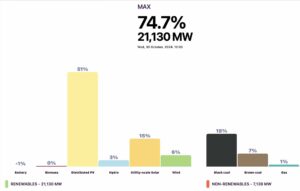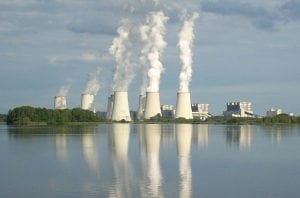The abrupt and unexpected departure of the Minerals Council of Australia’s CEO, Brendan Pearson, may well be a crucial tipping point in Australia’s debate over domestic energy policy.
On Friday afternoon the MCA Chair, Vanessa Guthrie, announced Pearson would be leaving in mid-October and that the peak coal and mining industry lobby group has yet to appoint a replacement. Pearson’s contract was reportedly not due to expire until the end of the year.
Disquiet within the lobby group’s member ranks has been growing for some time. An anonymous industry insider told the Australian Financial Review after Pearson’s announced departure that “BHP has got their man … BHP and Rio Tinto were not always comfortable with his coal advocacy.”
Central to understanding the MCA’s internal politics is recognition that membership fees are levied as a percentage of turnover member companies operations in Australia.
As a result the biggest mining companies – such as BHP and Rio Tinto – pay far more in membership fees than small-time start-ups like Adani which have no operating mining projects in Australia. (In 2016 the MCA’s budget was $12.5 million.)
Traditionally, industry associations’ primarily advocate only policies of benefit to the whole sector and refuse to take on campaigns that benefit only a single company. The MCA’s support for a public subsidy for Adani’s coal project upends that operating principle.
The clean energy undercurrent
Faced with the retirement of old coal plants, new ones being unbankable and the rapid cost decline of renewables, the MCA faced a dilemma: did it change tack and embrace renewables or demand public funding to prop up coal?
While the MCA had insisted for decades Australia’s economic policy should be about “industry competitiveness” it quickly morphed into a lobby group demanding billions in public subsidies for uncompetitive coal projects.
The MCA – and its state-based satellites the Queensland Resources Council (QRC) and the NSW Minerals Council (NSWMC) – came to support public subsidies for Adani’s unbankable Carmichael mine, an unneeded coal power station in Queensland, an unabated brown coal plant in Victoria and opposing AGL’s planned 2022 shutdown of the Liddell plant in New South Wales.
None of these are compatible with Australia’s commitments under the Paris Agreement, which BHP has stated it supports.
The proposed price tag for the coal subsidies may be huge but the National Party and the right-wing of the Liberal Party – egged on by credulous reporting in most of the Murdoch media mastheads – have danced to the MCA’s tune, even gleefully passing around in the national parliament a lump of coal the lobby group provided as a prop.
However, the MCA’s gung-ho promotion of coal and opposition to the Clean Energy Target proposed by the Finkel Review was one of the turning points for BHP.
Ben Potter from the Australian Financial Review reported an industry insider stating of that “I think his view was that if you let whatever movement win on coal then they’ll tick that box and move onto the next thing, and I think that drive [sic] his strident activism.”
In the last few years most of Australia’s power generators have come to accept that a transition away from coal is underway and inevitable.
Just as cheaper renewables are attractive to power generators as a way of lowering their costs, the same is true for energy-intensive mining and minerals processing operations, many of which operate in remote areas and are reliant on diesel generation or are exposed to the high costs of fossil-fuel grid power.
In West Australia, Sandfire Resources has installed a 10.6 megawatt (MW) off-grid solar farm at its DeGrussa copper mine while Rio Tinto installed a 6.7 MW solar plant at its bauxite operations in Weipa. (Both projects received funding from the Australian Renewable Energy Agency, an agency the MCA had campaigned to abolish.)
More recently, the grid-connected Whyalla steelworks is seeking to lower operating costs by investing in renewable generation and storage capacity.
For companies such as BHP, the MCA’s pro-coal embrace increasingly came with a lot of downside and few benefits.
What next for the MCA?
Having flexed its financial muscle within the MCA, BHP will now be under pressure to ensure the next CEO delivers significant policy change. But what policies do they want changed?
BHP insiders clearly identified the MCA’s opposition to the Clean Energy Target as a pivotal issue. (It is important to note that Finkel’s proposed clean energy target falls well short of what is required to achieve the Paris Agreement’s commitment to keep temperature increase to “well below 2 °C above pre-industrial levels.”)
However, the MCA – having stoked coal fever amongst the National Party and the right wing of the Liberal Party – may well find it harder to get the coal genie back in the bottle.
It also remains to be seen whether the MCA’s state-based affiliates in Queensland and NSW – which BHP is also a member of and exerts significant influence in – pull back on their promotion of new coal plants. At a minimum the CEO’s of the QRC and the NSWMC will be nervously wondering what the upheaval at the MCA might mean for them.
Whether the mining lobby groups’ can bring themselves to end their support for a taxpayer-funded lifeline for Adani’s stranded Carmichael coal project remains to be seen.
Subsidising Adani provides no benefit for existing exporters and, for some coal export companies, only ensures a new subsidised competitor enters the market at a time of huge uncertainty. To rub salt into the wound, Adani is only likely to be a minor financial contributor to the MCA coffers.
What other policies may be up for review is less clear. The MCA has spearheaded the attack on environmental and other NGOs which, while it may appeal to some conservative executives in the mining industry, is hard for companies such as BHP to defend in the eyes of investors in London.
Nor will BHP be able to easily turn a blind eye to lobbying activities of the World Coal Association – which it is a member of – which actively promotes the construction of new coal plants throughout Asia.
Just as the renewables revolution offers the prospect of lower costs for Australian consumers – including mining companies – the economic savings for countries such as Vietnam, which would be rely on expensive imported coal for new plants, would be even greater.
Having forced the dumping of the MCA’s CEO, BHP now faces a challenge closer to home. The resolution submitted to BHP shareholders by the Australasian Centre for Corporate Responsibility (ACCR) pressing for its exit from lobby groups such as the MCA remains live.
ACCR has welcomed Pearson’s departure – which is scheduled to occur around the time of BHP’s first AGM in London – but argues the problems with the MCA and its position run far deeper than the actions of one individual.
The Executive Director of Australasian Centre for Corporate Responsibility (ACCR), Brynn O’Brien, believes for BHP to justify continued spending shareholders money on its membership of the MCA the lobby group has to “unequivocally distance itself” from climate and energy positions taken during Pearson’s tenure. She also wants the MCA to end its push to limit NGO’s advocacy rights.
The challenge for BHP in re-orienting the energy and climate policies of the MCA, along with the other lobby groups it belongs to, has only just begun. Having spent years – and millions of dollars of shareholders’ funds – demonising renewable energy, the mining industry’s lobby groups now confront the need to acknowledge they got it all wrong.
Bob Burton is the Editor of CoalWire, a weekly bulletin on global coal industry developments. (You can sign up for it here.)









